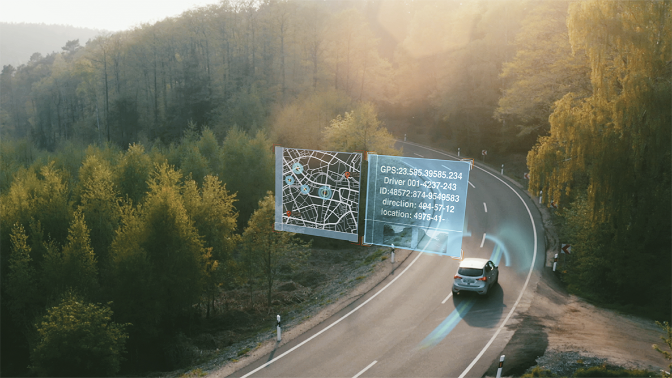As history taught us, the industry reinvents itself in response to widespread changes, present situations, challenges and consumers’ needs. The future of automotive promises nothing less than automated, personalized seamless driving experience that matches the needs, imaginations and aspirations of a modern consumer.
Software-driven transformation in automotive industry is gaining momentum
The transition from hardware to software is dramatic, causing tectonic shifts and four biggest disruptions in recent years — autonomous vehicles, connectivity, electrification, and shared mobility (ACES). Take Tesla, for example — its efforts to extend battery range through OTA and introduce autonomous-driving functionalities have certainly paid off increasing the community’s devotion to the brand. The rapid expansion of the software and electrical/electronics market is expected to have a CAGR of 12% from 2020 to 2030—more than three times the expected growth for general automotive sales.
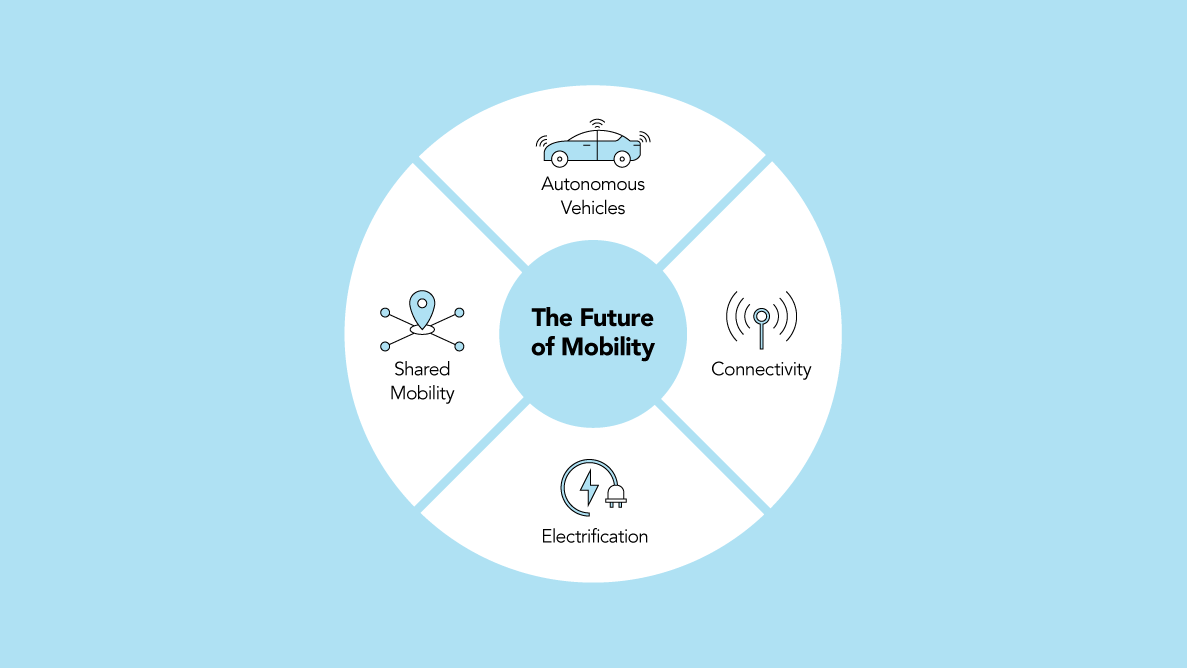
But, what is truly driving the reinvention in the automotive industry?
The hopes, movements, and discussions about health of our planet are more than ever in focus. Current trends such as zero emissions vehicles and carbon neutral manufacturing demonstrate the growing significance of sustainability in the automotive industry causing the industry’s shift toward electric vehicles (EVs) even faster than we imagined a few years ago.
Furthermore, a new generation of car buyers are creating a completely new concept of “cool” driving. Raw power, speed, and independence as status symbols are being suppressed by personalization, connectivity, and digitalization. Also, it seems that cars have ceased to be a status symbol for many and sharing instead of owning is becoming more and more suitable option for many consumers.
Finally, the pandemic led to the development of a consumer base focused on car ownership and software-defined functionalities to ensure safety and a highly personalized experience, much like when using a smartphone.
To catch and commercialize this next-generation vehicle, OEMs must transform not just the cars they make but also the ways they make them. To do that, automakers should take apart the engine of the traditional auto industry and rebuild it with software at the center. How? Through the four major trends disrupting the automotive industry:
- Autonomous driving (AD)
- Connected vehicles
- Electrification
- Shared mobility (ACES)
To elaborate on how these trends will impact not only the future of automotive but industries in general, we conducted a deep reserch and created a series of articles which will provide a more comprehensive insight into opportunities and challenges ahead. The first in the series of blogs delves into the current trends, risks and future of Autonomous Driving.
Dive right in!
The present state of autonomous driving
Autonomous vehicles leverage sensors, powerful computing, and artificial intelligence to sense their environment and operate efficiently and safely without a human driver. The development of AD (Autonomous Driving) technology is progressing from needing a driver’s assistance to creating a fully autonomous and driverless vehicle. While it is certainly a revolutionary change, its adoption will be evolutionary. Though fully autonomous vehicles are not yet on our roads, a significant number of advanced driver assistance features such as automatic emergency braking, parking assistants, driver monitoring, advanced cruise control, traffic jams pilots, and the interpretation of human driving behavior are already moving the needle in the transportation industry.
The shift to full self-driving vehicles will happen gradually feature by feature, as car companies will incorporate more and more advanced driver assistance (ADAS) features over the upcoming years. The autonomous driving solutions require real-time, high-performance software compliant with functional safety standards, while relying on self-healing maps, machine learning, AI, V2X connectivity and computer vision. To achieve their goals, many OEMs and top-tier companies are starting to invest in software-centered innovation, partnering with software development vendors to build autonomous driving solutions.
Where is autonomous driving being used?
While many tests are being conducted in real-world environments globally, autonomous technology is already being implemented in the global mining industry, on dangerous off-road locations without exposing humans to risk. But, autonomous vehicles are slowly finding their way on the roads. Google’s self-driving project Waymo carried out successful trials of autonomous taxis in California, transporting over 6,200 people in the first month and many thousands ever since.
On top of this, Walmart is using autonomous cargo vans to deliver groceries in Arizona, and Pizza Hut is collaborating with Toyota on creating a driverless electric delivery vehicle that has a mobile kitchen in it as well to cook pizzas on its way to your house. Manufacturing giants like Ford and Toyota Motor Europe are onboard, with over 1,400 self-driving vehicles now being tested by more than 80 companies.
What are the benefits?
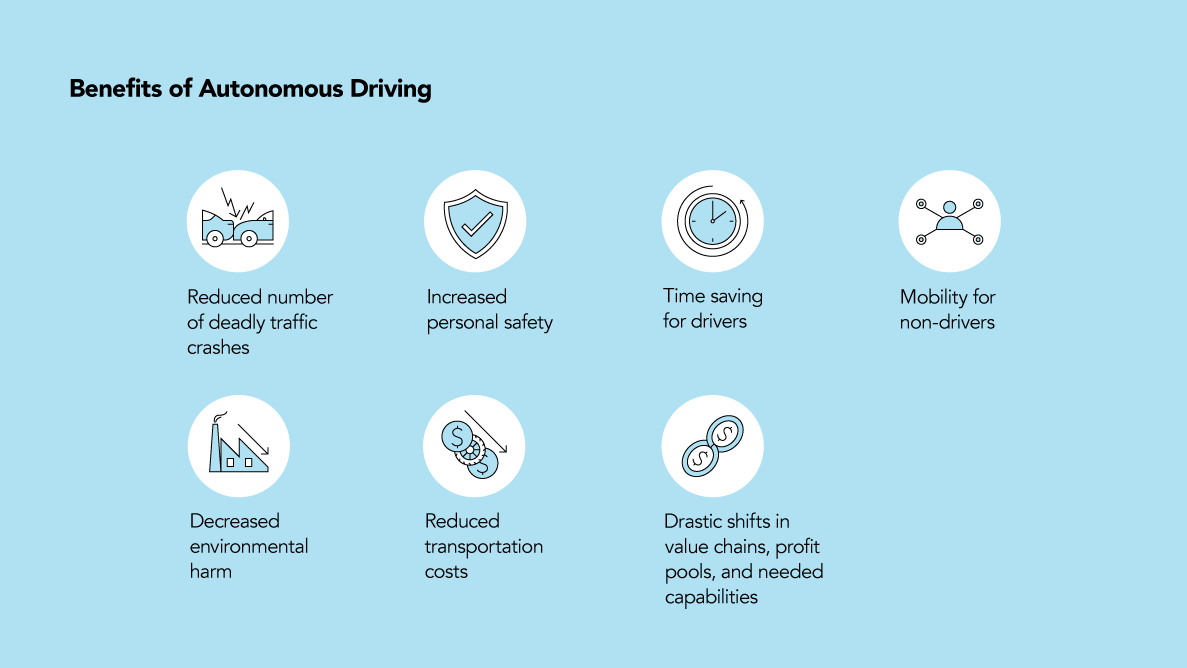
Trends
ADAS
OEMs and top-Tier providers are actively exploring certain core self-driving car technologies. And this is where ADAS (Advanced Driver Assistance Systems) technologies come as a critical piece of the puzzle. These systems help with monitoring, warning, steering and braking tasks critical for comfort, safety and ease of driving. The demand for these systems is expected to increase significantly in the following decade. While these technologies are still in the early days, OEMs and their suppliers are well aware that ADAS can become the main feature and the most important revenue source that differentiates automotive brands.
Regulatory and consumer interest in safety applications has made ADAS technology one of the fastest-growing segments in automotive market. Pillars of ADAS in automotive are crucial not only for autonomous driving but also for product differentiation. These include: Connectivity, Sensor, Actuator, Mapping, Processor and Software. It seems that sensor technologies are at the forefront of ADAS technology — ADAS vision systems and ADAS safety systems require lots of fused sensors to monitor the vehicle’s surroundings and what’s going on inside the car. On top of this, a variety of algorithms are powering life-saving systems. Among them, vision and image processing algorithms are real game changers for ADAS feature development.
When cars do become fully autonomous, there are also benefits beyond safe driving. The AD is bringing increased personal safety, but it also leads to more time saving for drivers, better mobility for non-drivers, decreased environmental harm, and reduced transportation costs (robo-taxi, shuttles, delivery).
The ultimate goal of ADAS feature development is to provide drivers with essential data and help them automate challenging and repetitive tasks. All of this will contribute to making our roads safer and better suited for fully autonomous vehicles in the long run. Consumers love the comfort and safety provided by parking assistance, blind zone monitoring, and other advanced systems.
The principal ADAS features and critical components behind each solution
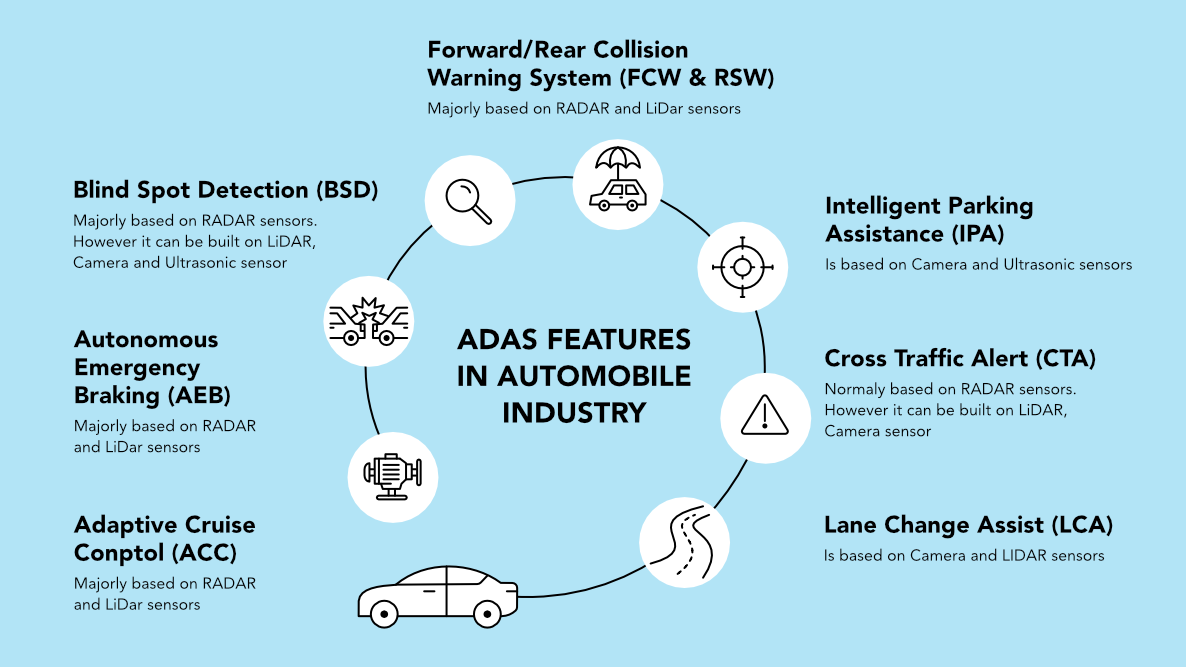
Risks
While Autonomous Driving is set to transform roadways and bring drivers’ safety to a much higher level, according to Sebastian Thrun who established and led Google’s self-driving project, it will take another fifteen years before self-driving cars outnumber traditional cars, maybe even longer. The reason for this is a series of roadblocks that need to be overcome to deliver the best results in the field of autonomous driving. Here are some of them:
Sensing the surrounding — Self-driving cars need to be able to detect road conditions and features regardless of the part of the day and weather conditions. Sensors play a major role here as they need to be reliable, compact and reasonably priced. Automakers are currently working on solutions, like using data from cars’ cameras to create up-to-date maps.
Unexpected encounters — Physical movements like a traffic officer waving vehicles or a kid who is about to step into the road might be a real challenge for a self-driving car — the computer cannot usually interpret unusual situations as it is hard to code for every possible scenario in advance.
Human-robot interaction — Figuring out who has the responsibilities and how the car should “know” when to notify the passenger who has been taking a nap or maybe reading a book that it is time for him/her to take over the task is one of the challenges that will prevent self-driving cars from being fully autonomous at least in the near future.
Ethical dilemmas — According to Iyad Rahwan, an MIT cognitive scientist, people who would want to buy these cars are mostly interested in how they can cater to the passanger’s needs. But there are many more participants in the traffic that need to be considered. This is why society will need to decide which rules and regulations should govern self-driving cars.
Cybersecurity — Since autonomous cars get updates and maps through the cloud, this means that they would be under a greater hackers’ attack. Essentially, the more computing leads to a greater risk as more and more cars will be exposed to cyber-attacks. For instance, hackers might disable someone’s car and hold it ransom until they receive a digital payment.
Public uncertainly — As with any new technology, there might be much uncertainty among the drivers about the car’s capability to assist with steering and other critical driving functions.
What’s next for autonomous driving?
Although some ADAS features like automatic emergency braking have been implemented in regular cars and have been shown to significantly reduce fatalities and injuries on the roads, the shift to fully autonomous vehicles will happen feature by feature after many tests and improvement.
According to some predictions, Level 3 and 4 cars will be available for the general public in around 10 years. The full self-driving type of vehicle, one that is called Level 5 autonomy, remains years into the future and the opportunities to continue with innovations are huge.
But the trend toward self-driving and electric vehicles will add hundreds of millions of lines of code to cars making the complexity of automotive software escalate on both the functional and architectural levels. However, it seems that development productivity is not rising at the same rate — software complexity in vehicles is rapidly outpacing the ability to both develop and maintain it. The trends are moving from dozens and even 100+ ECUs to several zone/domain ECUs.
Also, it seems that with the development of software-centred vehicles, there will be more benefits than just safe driving. This ground-breaking technology will significantly reduce the cost of travel as more and more people will be using cars as taxis, which would give them a chance to go on very inexpensive point-to-point travel. What’s more, logistics will fundamentally change as it may no longer be necessary to have drivers for long-haul transportation. Such changes could lower costs and might lead to shifts in value pools, such as the growth of e-commerce.
On top of this, robo-taxis and shuttles will be disruptive in different ways. They will provide greater convenience, better availability, and affordable mobility to people wo do not have driver’s licenses. McKinsey explains that this, in turn, might increase total miles travelled that customers would otherwise not undertake thus boosting travel by about 10 percent in our base-case scenario.
Furthermore, these major changes will have an enormous impact on the future of talent in automotive. In the next 10 years, automotive companies will need more workers trained in embedded software, robotics, and AI. It will require an entirely new skillset in ML, computer vision, sensor processing, and more to design the guiding intelligence of autonomous cars. Currently, automotive players fall short in the best engineering talent compared with tech companies. To close the gap, they must develop distinctive and targeted employer value propositions and take drastic steps to improve recruitment for top developers. Otherwise, the ever-increasing talent gap will continue to grow.
The race is ON! How can we help you win it?
HTEC engineers have worked on numerous state-of-the-art automotive-related projects for some of the most innovative companies in the world of automotive including premium OEMs, Tier 1 and chip suppliers. By leveraging cutting-edge technologies of tomorrow and backed up by extensive experience in ADAS engineering, high-performance code, data fusion, and building ML and AI algorithms, our team of experts have been working on developing highly automated and safe driving systems that will revolutionize the way we move around.
By creating fully autonomous vehicles that will provide greater reliability and safety than human-operated vehicles we help global companies unlock new value and drive world-changing innovation.
How we help spark the autonomous driving revolution
1. Building vehicles with different levels of autonomy
Using cutting-edge technologies for multiple innovative companies, HTEC is helping create vehicles with different levels of autonomy. The tech-stack behind covered data engineering for complex decision-making in real-world scenarios in the automotive context with the ability to handle hundreds of terabytes of incoming data daily. Key outcomes: Workflow Orchestration, Data Storage, Data Versioning.
2. Creating an end-to-end standalone embedded solution for Driver Monitoring System (DMS) and Occupancy Monitoring System (OMS) using the latest technologies
Sophisticated driver monitoring can help prevent traffic accidents by alerting the driver when the system detects the individual is distracted or falling asleep at the wheel. This is an optical system based on NIR (Near InfraRed) camera and advanced automotive SoC. In order to achieve the final goal, different dedicated cores (e.g., DSPs) must be utilized as much as possible, as well as dedicated HW accelerators for deep learning, computer vision and other pixel intensive tasks.
3. Developing referent ADAS platforms for rapid prototyping and proof of concept (PoC) designs
4. Developing and optimizing ADAS functions and algorithms
5. Processing sensor information including the camera module, image sensor, and data fusion from multiple sensors
6. Benchmarking and performance evaluation of various Software Components for concepts evaluation of ADAS systems
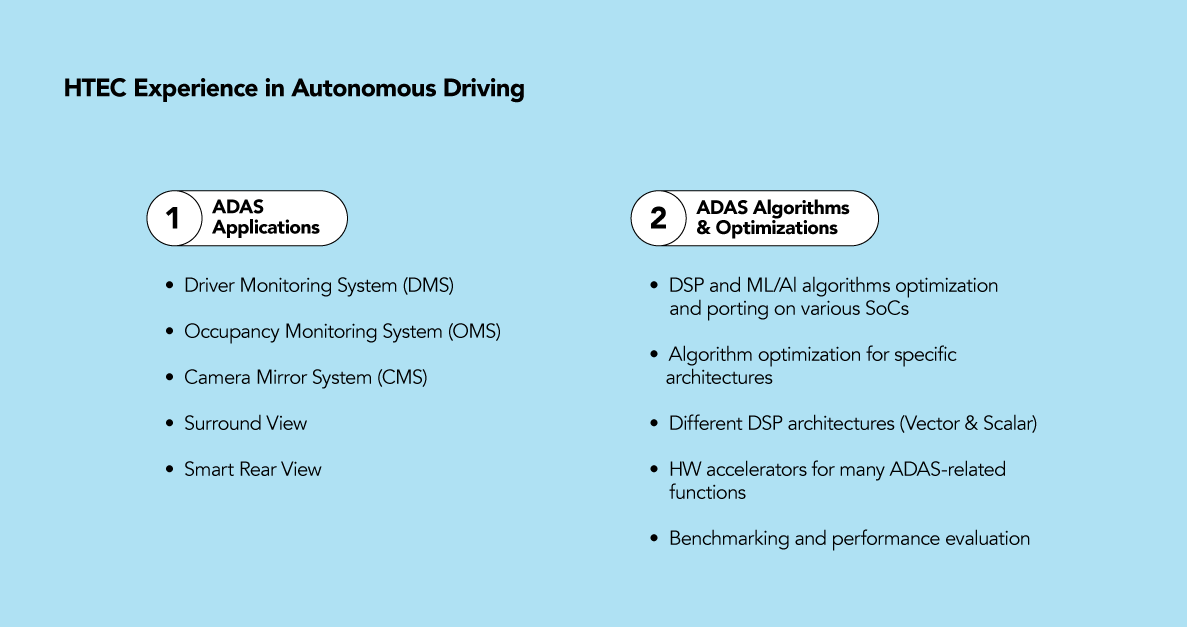
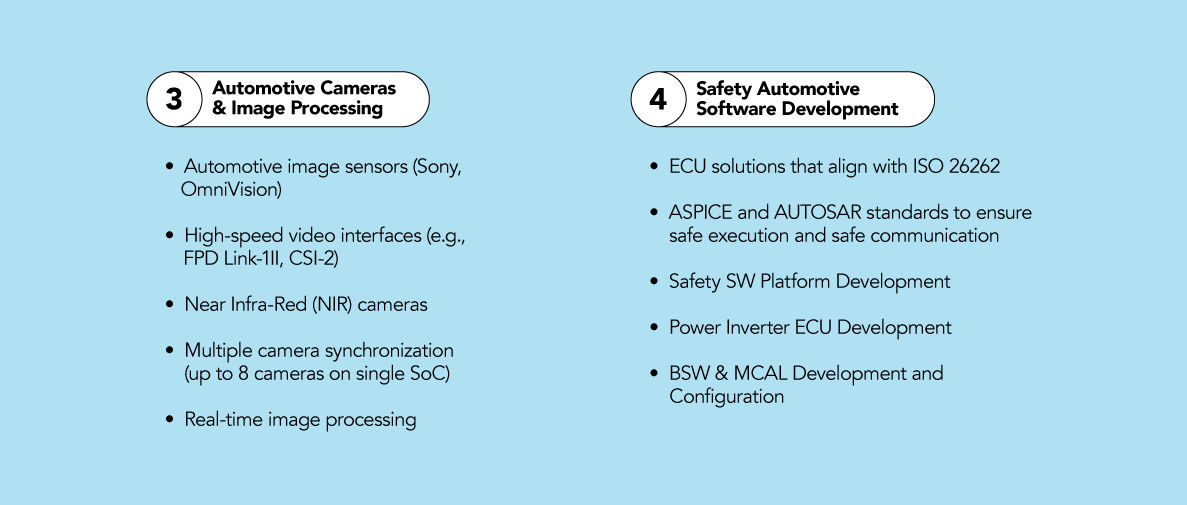
—
Driven by our mission to get out of our comfort zones and search for innovative solutions to some of the most complex worlds’ problems, our team of skilled domain experts is here to help you navigate your digital journey towards a more connected and digitized world.
Reach out to our experts to learn how we can help you get beyond the wheel.
